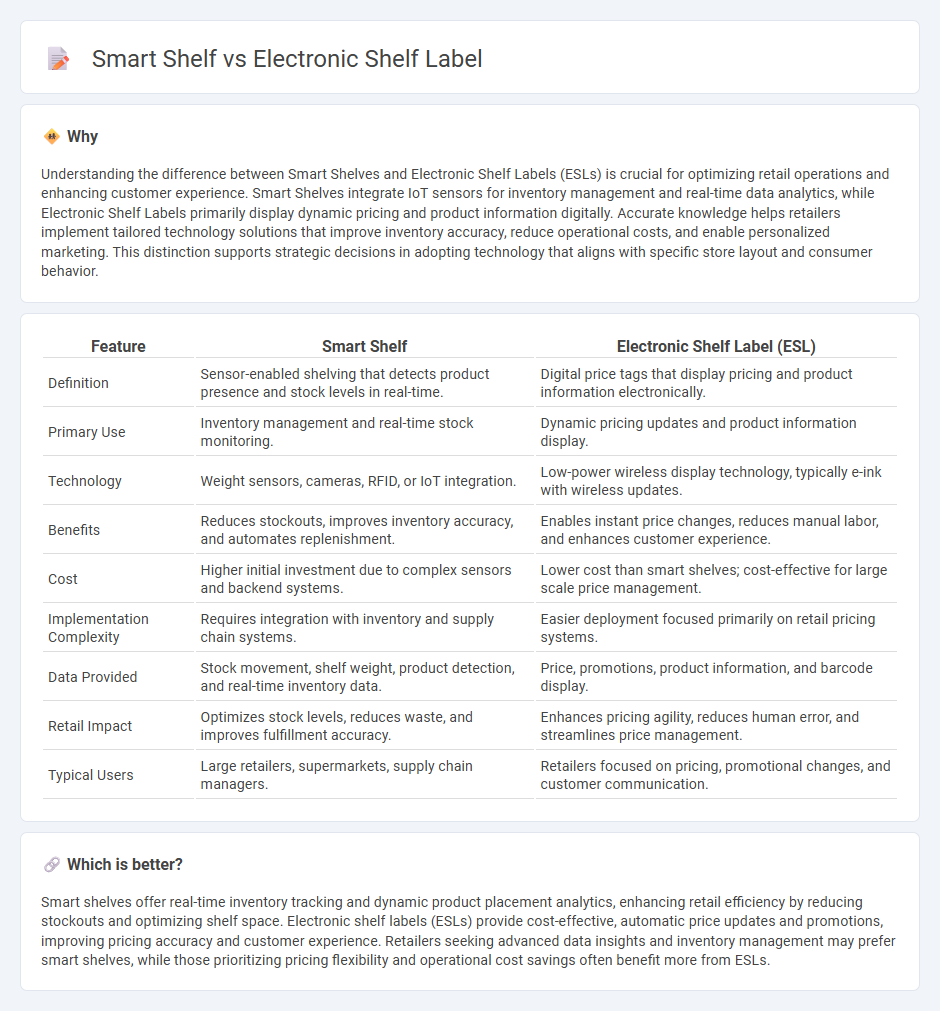
Smart shelves utilize sensors and IoT technology to automatically track inventory levels, analyze shopper behavior, and optimize product placement in real-time, enhancing operational efficiency and customer experience. Electronic shelf labels (ESLs) replace traditional paper price tags with digital displays that allow retailers to update prices and product information instantly across multiple locations, reducing labor costs and pricing errors. Explore how integrating smart shelf systems and ESL technology can revolutionize retail management and boost sales.
Why it is important
Understanding the difference between Smart Shelves and Electronic Shelf Labels (ESLs) is crucial for optimizing retail operations and enhancing customer experience. Smart Shelves integrate IoT sensors for inventory management and real-time data analytics, while Electronic Shelf Labels primarily display dynamic pricing and product information digitally. Accurate knowledge helps retailers implement tailored technology solutions that improve inventory accuracy, reduce operational costs, and enable personalized marketing. This distinction supports strategic decisions in adopting technology that aligns with specific store layout and consumer behavior.
Comparison Table
| Feature | Smart Shelf | Electronic Shelf Label (ESL) |
|---|---|---|
| Definition | Sensor-enabled shelving that detects product presence and stock levels in real-time. | Digital price tags that display pricing and product information electronically. |
| Primary Use | Inventory management and real-time stock monitoring. | Dynamic pricing updates and product information display. |
| Technology | Weight sensors, cameras, RFID, or IoT integration. | Low-power wireless display technology, typically e-ink with wireless updates. |
| Benefits | Reduces stockouts, improves inventory accuracy, and automates replenishment. | Enables instant price changes, reduces manual labor, and enhances customer experience. |
| Cost | Higher initial investment due to complex sensors and backend systems. | Lower cost than smart shelves; cost-effective for large scale price management. |
| Implementation Complexity | Requires integration with inventory and supply chain systems. | Easier deployment focused primarily on retail pricing systems. |
| Data Provided | Stock movement, shelf weight, product detection, and real-time inventory data. | Price, promotions, product information, and barcode display. |
| Retail Impact | Optimizes stock levels, reduces waste, and improves fulfillment accuracy. | Enhances pricing agility, reduces human error, and streamlines price management. |
| Typical Users | Large retailers, supermarkets, supply chain managers. | Retailers focused on pricing, promotional changes, and customer communication. |
Which is better?
Smart shelves offer real-time inventory tracking and dynamic product placement analytics, enhancing retail efficiency by reducing stockouts and optimizing shelf space. Electronic shelf labels (ESLs) provide cost-effective, automatic price updates and promotions, improving pricing accuracy and customer experience. Retailers seeking advanced data insights and inventory management may prefer smart shelves, while those prioritizing pricing flexibility and operational cost savings often benefit more from ESLs.
Connection
Smart shelves integrate sensors and data analytics to monitor inventory in real time, while Electronic Shelf Labels (ESLs) dynamically display pricing and product information. Both technologies connect through IoT platforms to enhance retail operations by enabling automatic updates, reducing manual errors, and improving inventory accuracy. This integration streamlines shelf management, optimizes stock levels, and enhances the overall customer shopping experience.
Key Terms
Dynamic Pricing
Electronic shelf labels (ESLs) offer real-time price updates, enabling retailers to efficiently implement dynamic pricing strategies through centralized control systems. Smart shelves incorporate sensors and IoT technology to monitor inventory and customer interactions, providing data that enhances dynamic pricing accuracy by reflecting demand and stock levels. Discover how integrating ESLs with smart shelf technology can maximize pricing agility and boost retail profitability.
Inventory Management
Electronic shelf labels (ESLs) provide real-time price updates and product information, enhancing shelf accuracy but primarily focusing on display rather than tracking inventory levels. Smart shelves integrate weight sensors, RFID, or IoT technology to monitor stock quantities, detect product movement, and automate inventory management processes more effectively. Explore how smart shelf solutions revolutionize inventory control for retail businesses by learning more about their technology and applications.
Real-time Data Integration
Electronic shelf labels (ESLs) provide static price and product information updates through wireless communication, ensuring consistent pricing accuracy. Smart shelves enhance real-time data integration by combining weight sensors, RFID technology, and inventory management software to monitor stock levels and customer interactions instantly. Explore how these systems revolutionize retail efficiency and customer experience.
Source and External Links
Electronic shelf label - Wikipedia - An electronic shelf label (ESL) system displays product prices on retail shelves and can be automatically updated via a central computer, usually using e-paper or LCDs with wireless communication, offering dynamic pricing and additional product info while facing challenges like error propagation and investment quantification.
Pricer | The World's Most Reliable Electronic Shelf Labels (ESL) - Pricer provides enterprise-grade ESL solutions with automatic price updates, cloud-based management, and low total cost of ownership, helping retailers improve accuracy and operational efficiency globally since 1991.
electronic shelf labels - specialist for electronic price tags and digital ... - e-shelf-labels offers complete ESL infrastructure, including digital labels, software, and support, enabling omnichannel retail solutions and real-time price and stock updates to digitize and optimize store operations.
 dowidth.com
dowidth.com